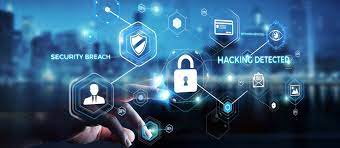Cybersecurity and data privacy are two critical concerns in today’s digital age. With the increasing reliance on technology and the internet, personal and sensitive information is now more vulnerable to theft, misuse, and manipulation. As such, it’s crucial to understand the significance of cybersecurity and data privacy and how to safeguard your information.
To ensure cybersecurity and data privacy, individuals and organizations must adopt best practices such as regularly updating software and security systems, using strong passwords, and being cautious of suspicious emails or websites. Organizations must also implement data privacy measures, such as performing regular data audits and implementing data protection policies for employees.
In this guide, you will learn about the different types of cyber threats, how to protect your personal information online, and the role of laws and regulations in safeguarding data privacy.
What is Cybersecurity?

Cybersecurity is a branch of Computer Science responsible for protecting internet-connected systems, including hardware, software, and data, from attack, damage, or unauthorized access. This protection is necessary to ensure the confidentiality, integrity, and availability of data and systems. Cyberattacks can come in various forms, including malware, phishing, and ransomware, and can have severe consequences, such as theft of sensitive information, financial loss, and damage to reputation.
In today’s digital world, where almost every aspect of our lives is connected to the internet, cybersecurity has become a critical concern. The increasing reliance on technology has led to an exponential growth of sensitive information being stored and transmitted online, making it vulnerable to theft, manipulation, and misuse. From personal identification details to financial information, data breaches can result in severe consequences, including financial loss, damage to reputation, and even loss of personal privacy. It’s vital to understand the importance of cybersecurity and why it’s necessary to protect our digital assets and information from malicious cyber actors.
Also Read: 9 Safety Tips To Prevent Cybercrime In 2022
Types of Cybersecurity Threats

Cyber threats are a growing concern in the digital age, as individuals and organizations rely heavily on technology for their daily operations. A cyber threat refers to any malicious act that aims to disrupt a digital setup in an organization. These threats can take many forms, including computer viruses, data breaches, and Denial of Service (DoS) attacks, and can originate from within the organization or from external sources. In order to understand the importance of cybersecurity and why it’s necessary, it’s essential to be aware of the most common cyber threats and how they can impact individuals and organizations.
- Malware:
This refers to malicious software that can infect a computer system, allowing hackers to access sensitive information and personal data. Hackers often trick users into clicking on links or emails that contain malware, which can then infect their computer system and give hackers access to their credentials. - Phishing:
This refers to scams in the form of emails or links that appear to be from genuine and trustworthy sources but actually contain malicious software. By tricking users into entering their personal information, hackers can gain access to sensitive data and use it for their own gain. - Man-in-the-middle attacks:
This occurs when an attacker intercepts a transaction of data between two parties, either by monitoring unsecured public connections or by installing malware on a computer system. This allows the attacker to collect sensitive information, such as account credentials, that can be used for malicious purposes. - DDoS attacks:
This refers to a type of attack where hackers overload a network or server with an excessive amount of data, causing it to stop functioning temporarily. During this time, the attackers can access sensitive data or install malware on the system. - Snooping or sniffing:
This occurs when data is sent over networks that are not encrypted, allowing individuals to monitor and review the type of data sent over them. Hackers can easily trace the data packets to the sender and collect sensitive information. - SQL injections:
This refers to the addition of malicious code to a Structured Query Language (SQL) server, which can cause it to reveal sensitive information it’s not supposed to. This type of attack can be initiated by simply adding malicious code to a website’s search box, making it easy for hackers to access sensitive data.
In conclusion, cyber threats are a growing concern that can have severe consequences for individuals and organizations. It’s essential to be aware of the most common types of cyber threats and take measures to protect personal and sensitive information from malicious cyber actors.
Also Read: How To Prevent Cyberattacks With Windows AppLocker?
Categories of Cyber Security

Cybersecurity encompasses a wide range of concerns related to businesses, technology, data, and mobile computing. To better understand the scope of this field, it’s often divided into several key categories:
- Network Security:
This aspect of cybersecurity focuses on protecting the network infrastructure of an organization. This is important as network systems are often targeted by cyber criminals looking to gain access to sensitive information or disrupt operations. - Application Security:
This type of security focuses on securing software and devices from cyber threats. It starts at the design stage and continues throughout the development and deployment of the software. A security breach in an application can result in unauthorized access to sensitive data. - Information Security: Information is a valuable asset, and protecting it from cyber threats is crucial. Information security involves safeguarding the privacy and integrity of data during storage and during its transformation from one form to another.
- Operational Security: Data handling is an important aspect of any business, and operational security is concerned with the rules and protocols that govern the use, access, storage, and transformation of data. This includes ensuring that the right security measures are in place to prevent data breaches.
- Disaster Recovery: This aspect of cybersecurity is critical in the event of a cyber attack. A proper disaster recovery plan helps to quickly restore services, minimizing downtime and maintaining business continuity. It’s important to work with an IT help desk that offers disaster recovery services.
- End-User Education: Data breaches can often occur as a result of user ignorance or carelessness. For example, plugging in an infected USB drive or opening a malicious email can lead to a security breach. To prevent these types of incidents, it’s important to educate end-users on how to follow security protocols and avoid potential threats.
Also Read: Top 6 Security Blunders That Put Your Computer At Risk
What is Data Privacy?

Data privacy refers to an individual’s right to control and manage their personal information, including information such as name, address, Social Security number, and sensitive information like medical records and financial information. It encompasses three key elements: compliance with data privacy laws and regulations, the right of individuals to control their personal data, and proper procedures for collecting, handling, processing, and sharing personal information.
Laws such as the General Data Protection Regulation (GDPR) in Europe and the California Consumer Privacy Act (CCPA) in the United States have been established to protect individuals’ personal information and ensure that it is not accessed, used, or disclosed without their consent.
Data privacy is a crucial aspect of the broader field of data protection and involves ensuring compliance with data privacy regulations and respecting individuals’ expectations of privacy. Companies must take steps to properly handle, collect, process, and share personal information to protect the privacy rights of individuals.
Personal data can be broadly categorized into two types: sensitive personal data and non-sensitive personal data.
- Sensitive Personal Data: Sensitive personal data refers to information that is particularly sensitive and requires a higher level of protection. This includes information such as an individual’s racial or ethnic origin, political opinions, religious beliefs, trade union membership, genetic data, biometric data, and data about their health, sex life, or sexual orientation. In many jurisdictions, there are specific regulations that govern the collection, storage, and use of sensitive personal data to ensure its protection.
- Non-sensitive Personal Data:
Non-sensitive personal data refers to information that is less sensitive in nature. This includes information such as an individual’s name, address, phone number, email address, and other similar contact information. While this information may still be considered personal data and requires protection, the level of protection is typically lower than that required for sensitive personal data.
It’s important to note that while certain types of personal data may be considered non-sensitive in one jurisdiction, they may be considered sensitive in another. Companies must be aware of the different regulations and laws that apply to personal data in the jurisdictions in which they operate to ensure that they are complying with data protection requirements and protecting the privacy rights of individuals.
Also Read: Tips To Protect Your Business Against Cyber Crime
Steps to Protect Your Data
Data protection is a critical issue in industries that store vast amounts of personal data, including sensitive information such as credit card details and social security numbers. To ensure the protection of clients’ data, businesses must adhere to data protection laws that give individuals control over their personal information and empower them to know how their data is being used.
In order to protect personal data from potential cyber threats, companies can implement several security measures to enhance their defense. These measures include:
- Firewalls:
A firewall is a crucial component in securing a network and acts as the first line of defense against malicious traffic. It can be configured to restrict certain types of traffic and perform verification, ensuring that only authorized traffic is allowed to enter the network. - Regular Software and Operating System Updates:
It’s important for companies to keep their software and operating systems up-to-date with the latest security patches to ensure the protection of sensitive data. Outdated software is often vulnerable to cyber-attacks, so regular updates are crucial in maintaining the security of the system. - Advanced Anti-Virus Software:
An anti-virus software is a must-have tool for data privacy protection. It detects and removes malware that can steal, damage, or modify sensitive data. Having a robust anti-virus software in place is crucial in ensuring that sensitive data remains secure and protected from cyber threats. - Strong Passwords:
Passwords are the first line of defense in preventing cyber-attacks, so it’s essential to use strong passwords that are not easily guessable. Companies can enforce password policies and encourage their employees to use unique, complex passwords for their accounts. - Avoiding Emails from Unknown Senders:
Emails from unknown sources, especially those with attachments, can carry malware and should be avoided. Companies can educate their employees on the importance of avoiding emails from unknown sources and encourage them to be vigilant when opening emails. - Avoiding Public Wi-Fi Networks:
Public Wi-Fi networks can be insecure and may leave users vulnerable to cyber-attacks. Companies can advise their employees to avoid using public Wi-Fi networks, especially for sensitive data transmission, and instead use secure, encrypted connections to access their data. - Data encryption:
Encryption ensures that sensitive data cannot be easily accessed, even if it is stolen. Encrypted communication protocols secure common data such as passwords and credit card numbers. Companies storing critical information on desktop systems should consider encrypting their hard drives to prevent data loss. Hardware-based data encryption, such as Trusted Platform Module (TPM), can also be used to protect smartphones and PCs. - Security Information and Event Management:
SIEM provides real-time analysis of security logs recorded by servers, software applications, and network devices. It is often used for security investigations and can remove multiple reports on the same instance, triggering alerts based on predetermined criteria.
By implementing these security measures, companies can take steps to protect sensitive personal data and ensure compliance with data protection laws.
Also Read: Increasing Cyber Crime and how to avoid becoming a victim of it? (Heimdal PRO…
Data Privacy Laws
The digital age has brought about major changes in various industries, with easy access to data being both a blessing and a curse. The increasing concern over data privacy has led to a global demand for regulations to protect personal information. To date, around 100 countries across all six continents have implemented laws and policies that aim to safeguard data and consumer information. A few of the most common data privacy laws are:
- General Data Protection Regulation (GDPR)
One of the most prominent data privacy laws is the General Data Protection Regulation (GDPR). This legislation governs data protection, privacy, and security in the European Union and the European Economic Area. The GDPR sets strict and far-reaching standards for companies, governments, and businesses on handling user data. Organizations are required to protect the privacy of their customers and keep Personally Identifiable Information (PII) safe. The act contains principles that organizations must abide by, including the safekeeping of data, not storing data for longer than necessary, using data within the confines of the law, and using data in specific, relevant ways. - California Consumer Privacy Act (CCPA)
Another notable law is the California Consumer Privacy Act (CCPA). In 2003, California enacted the Online Privacy Protection Act to require commercial websites to include a privacy policy. The CCPA mandates that companies must inform users of data processing and protect user information, allowing users to have control over what data is collected and how it is used. New York has also implemented similar data privacy laws and regulations. The CCPA came into effect on January 1, 2020, with accountability, transparency, and control as its guiding principles. - Health Insurance Portability and Accountability Act (HIPAA)
Finally, the Health Insurance Portability and Accountability Act (HIPAA) is a federal law that addresses the disclosure and use of individual physical condition information (known as Protected Health Information). HIPAA created national standards to protect sensitive patient information from being disclosed to third parties without the patient’s consent. Data privacy laws and regulations in the United States are enforced at the federal level.
What to do if you fall victim to an attack
In the unfortunate event of a cyberattack, it is important to take immediate action to mitigate the damage and secure your systems. Here are the three steps to follow in the aftermath of a cyberattack:
- Containment:
The first step is to isolate the breach and prevent it from spreading to other parts of your network. This includes disabling remote access, installing any pending updates, maintaining firewall settings, changing passwords, and disconnecting any devices associated with the breach from the internet. The goal is to contain the breach and limit its impact. - Assessment:
Once the breach has been contained, it is time to assess the situation and determine the extent of the damage. This involves identifying which servers were affected, who had access to them, and which networks were active during the breach. It is also important to assess the impact on staff, customers, and clients, including any potential data breaches and financial losses. This is also an opportunity to assess how you can train your staff to prevent future breaches. - Management:
The final step is to manage the situation and communicate transparently with those who have been impacted. This includes letting everyone know what has happened, being clear about the possible data that has been accessed, and showing willingness to speak with anyone who has been affected. Consider setting up a dedicated hotline for people to call and discuss the situation and be as open and honest as possible to preserve relationships after a security breach.
The Future of Cybersecurity and Data Privacy

The future of cyber security promises to be a dynamic and ever-evolving landscape, with an increased emphasis on prevention and preparedness. Companies will need to be proactive in their approach, starting with employee training to minimize human error and implementing response playbooks for security incidents and data breaches.
As regulatory bodies crack down, businesses must ensure their cyber security programs are strong enough to pass any audits or compliance assessments. Building a solid foundation of cyber security best practices is essential to staying ahead of the constantly evolving threat landscape.
It’s difficult to predict exactly what the future holds in such a fast-paced industry, but by investing in strong cyber security measures today, businesses can set themselves up for long-term success, no matter what challenges arise. Don’t wait until it’s too late – take action now to secure your company’s future.
Conclusion
Cyber security and data privacy are crucial components of a successful and sustainable business model. By implementing the right security measures and keeping up to date with the latest advancements in the industry, companies can safeguard their sensitive information from potential cyber threats. Whether it be through firewalls, anti-virus software, strong passwords, or regular software updates, there are countless ways to stay ahead of the curve. Moreover, with an increased emphasis on prevention and preparedness, companies can be confident in their ability to respond and recover from any potential data breaches. By proactively addressing the ever-evolving challenges of cyber security, companies can protect their customers, employees, and reputation for years to come.



















![Samsung’s Innovation Sparks Progress in Science and Industry: Quantum Dots How Samsung’s Engineering Feat Became a Catalyst for Scientific and Industry Advancement [Interview on Real Quantum Dots Part 2.]](https://www.hawkdive.com/media/samsung-tvs-and-displays-samsung-quantum-dots-technology-qled-tvs-quantum-dots-experts-interview-par-218x150.jpeg)
















